Omnichannel Customer Engagement: Everything You Need To Know
Companies with a strong omnichannel strategy retain an average of 89% of their customers, which is proof that consistency across different channels drives real results.
How do you achieve something similar?
Start with this article. We will explore what omnichannel customer engagement is and the benefits it brings. We will also share how you can create a strategy that delivers a seamless experience and increases customer satisfaction.
By the end of your read, you will be ready to engage customers no matter where or how they interact with your brand and cut your selling process short.
Omnichannel Customer Engagement: The Secret To Feeling Everywhere At Once
Omnichannel customer engagement is a part of a larger digital marketing strategy that lets you connect with your customers across multiple channels, like:
- In-Store
- Live chat
- Social media
Then, you do it in a way that feels smooth, personal, and consistent. You treat every interaction as part of one continuous conversation, no matter where it happens.
How does omnichannel compare against other customer engagement approaches?
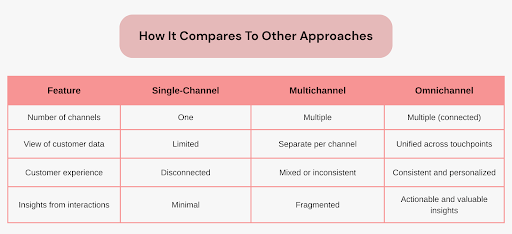
Now, here’s how omnichannel works:
Start with unifying customer data from every touchpoint to get a full picture of your customer behavior. Instead of treating channels separately, you link them together.
Then, you map out your key customer interactions across platforms to spot gaps and create smoother transitions. Finally, you use those insights to personalize each step of the journey for your target audience.
This is especially crucial in niches like real estate, where deals involve long conversations, changing preferences, and multiple customer touchpoints over time. Suppose you own a property agency and a potential buyer:
- Books a home tour through your website
- Asks follow-up questions via email
- Calls to negotiate
Your team instantly sees the full timeline of those customer interactions because you already unified customer data across touchpoints, so your agents do not miss a beat.
The result?
- For you: Smoother handoffs, faster responses, more closed deals, and even positive publicity from happy clients who share their great experience.
For your customers: A seamless, personalized experience, from first inquiry to final walkthrough, that makes buying a home feel less stressful. Still Debating Omnichannel? Here’s Why It Is Worth It
Review these benefits and share them with your team to encourage them to become experts at omnichannel engagement so you can all work together to turn these wins into everyday results.
I. Higher Order Value
Brands using an omnichannel approach see a jaw-dropping 494% higher order rate than those sticking to a single channel.
Why does it work so well?
Because when you give people a consistent customer experience wherever they interact with you, they feel more confident hitting that buy button. They are not second-guessing, bouncing around, or waiting for answers.
They get what they need, when they need it, in a way that feels natural. When everything clicks, it increases the chances of them placing bigger orders.
II. Shortens The Sales Cycle
Omnichannel removes friction at every step of the customer journey to shorten your sales cycle. When your team sees the full history of customer communication, across chat, email, phone, or in person, they skip the catch-up phase and dive straight into solving the buyer’s need.
No repeats. No confusion. Just momentum.
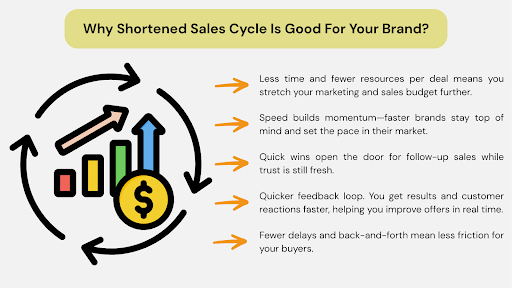
For example, let’s say you are in the tech niche selling shipping calculation software. A potential buyer sends an email asking about integration with their eCommerce platform and later calls to clarify zone-based pricing.
Your team already sees the full trail (what they asked and where they need help), so they can skip the small talk and guide them straight to a solution. That speed and clarity keep the conversation focused and fast, so deals close quicker.
III. Turns Support Tickets Into Sales Opportunities
Omnichannel gives customer service representatives the full picture of every interaction. So when they handle customer queries, they can spot interest signals and pass them directly to your marketing team or sales.
For example, if a customer asks about feature limits during a support chat, your rep can see they also viewed pricing pages and clicked on upgrade emails. Instead of just answering the question, the rep tags the lead and notifies the sales or marketing team to follow up with a tailored offer.
With that kind of teamwork, you can turn everyday support into a steady flow of qualified leads.
From Disconnected To Unified: Build Your Omnichannel Game Plan
Highlight the practical points in this section and use them to shape an omnichannel customer engagement strategy your team can apply across every channel, touchpoint, and customer interaction.
Step 1: Break Down Your Current Customer Engagement Flow
Zoom in on how your brand connects with customers, from first touch to post-purchase, to see what is working and what is not. When you know how engagement happens across the customer lifecycle, use the valuable insights to:
- Fix friction
- Improve timing
- Create a smoother journey
In addition, this lets you see where they lose interest or where you are missing your chance to engage them.
How To Do This
List all your communication channels to see the full picture. Then, use data analytics tools to follow the customer journey and identify common drop-off points or engagement gaps. Each tool gives you unique insights into specific parts of the journey:
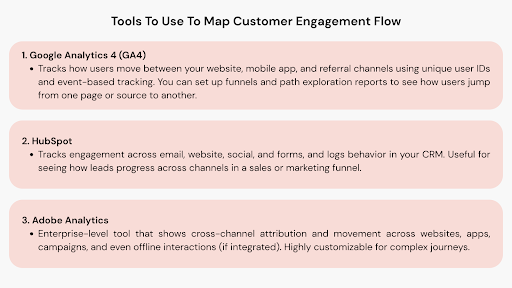
Additionally, gather customer feedback and ask how they feel at each stage. Short surveys or support tickets are great for collecting data you will not find in dashboards.
Now, if numbers and graphs are not your strong suit, get a data analyst who has experience with the tools you are using. They can help spot patterns and pain points. Plus, they can look for stages where engagement slows down, repeats, or confuses the customer.
Step 2: Pinpoint The Channels That Drive Action
Figure out which channels move your customers to act. Why do this instead of just using everything?
It is not about being everywhere; it is about being present on the preferred channels that convert. If you try to engage customers on every platform, you will burn resources. But when you know your audience’s customer preferences, you can create a targeted, high-impact omnichannel experience that drives results, not noise.
How To Do This
Use UTM parameters to track exactly which email or social post drives traffic and conversions.

Another way to pinpoint the channels your customers prefer is to compare open, click, and conversion rates across platforms. You can also ask new leads how they heard about you. A simple question on forms or calls can reveal a lot.
Here are more ways to do this step:
- Compare channel performance during launches. When you release something new, track which channels create the biggest spike.
- Check customer support tickets to see which channels bring in questions that lead to sales or interest.
- Monitor DMs or comments on social posts. Conversations can show which platforms drive interest and intent.
Step 3: Let Each Channel Shine While Playing As A Team
Give every channel a specific role based on what it does best, while making sure they all support the same goal.
**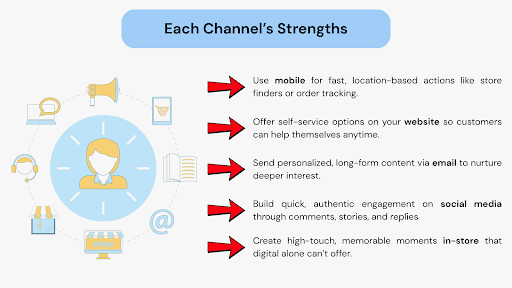
How do those actions help create a unified experience?
Instead of repeating content or confusing the customer with mixed messages, you guide them forward step by step, no matter which touchpoint they choose.
For example, let’s say you are in the toy niche selling products like these customizable playhouses. Here’s how each channel can create a consistent rhythm where every interaction feels connected, not isolated:
- A customer sees a social media video showing a new playhouse model.
- They click through to your mobile site to check specs, explore customization features, like paint colors, add-ons, and roof styles, and find the nearest store.
- At the store, they explore a full-size model and ask a few questions in person.
- Later, they receive a personalized email with setup tips, care instructions, and a summary of their chosen custom features.
- Finally, they return to the website to access self-service options like tracking delivery or booking installation.
Remember, this is not about copy-pasting messages; it is about creating a personalized customer experience that feels intentional and connected.
Your customer expects more than just presence. They expect fluidity. When one channel drops the ball or repeats what another just said, it breaks trust.
But with careful planning, you create a journey where each channel picks up right where the last one left off, and that is how you exceed customer expectations.
How To Do This
Here’s what your team should do to act on this effectively:
- Build fallback experiences for each channel, like sending a follow-up email if an in-app message is not opened.
- Use automation tools to trigger next-step messages, like sending an SMS after someone abandons a cart on mobile or reminding them in-app.
- Build a shared content calendar across teams to align campaigns, launches, and promos on every channel without mixed signals.
- Create shared channel guidelines so teams know how to tailor content by platform. For example, short and punchy for SMS, visual for social, and detailed for email.
Winning Moves For Smarter Omnichannel Engagement
Highlight the ideas that match your current gaps and use them to improve consistency, increase efficiency, and grow customer loyalty across channels.
1. Embrace Proactive Communication
In any omnichannel engagement strategy, proactive communication is a game-changer because it shows your customers that your brand is always one step ahead. When you anticipate customer needs and offer help before they ask, you:
- Build trust
- Create a smoother experience
- Remove friction that prompts drop-offs
That kind of responsiveness goes beyond making them feel good, it also helps you build customer loyalty and drive repeat business.
How do you do this?
Use tools like CrankWheel for features like “Instant Demos” that connect your inbound leads with an agent within seconds, before they lose interest. You jump in right when they are curious. No waiting, no follow-up emails, just instant answers when they matter most.
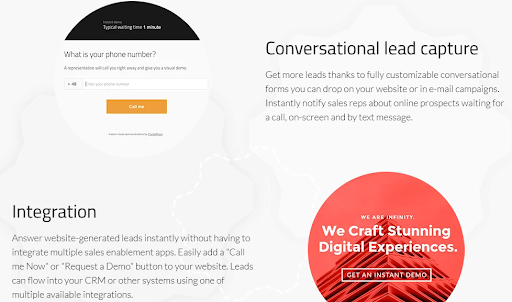
Here are more ways to be proactive:
- Proactively offer live chat when customers linger on pricing or checkout pages.
- Send automated follow-ups after key actions like product views or downloads.
- Set up email reminders for abandoned carts, trial expirations, or upcoming renewals.
- Notify customers when back-in-stock or price drops happen on items they viewed.
2. Train Teams Across All Touchpoints
If your different teams do not understand how their role fits into the full journey, your supposed omnichannel customer experience will always feel disjointed.
Why? Because engagement is not just about tools; it is about the people.
When your customer support teams, sales reps, marketers, and in-store staff all know what is happening across channels, they create smoother handoffs and deliver faster, more helpful responses.
Here’s what you need to do:
- Offer short, ongoing micro-training on new tools, features, or messaging.
- Create quick-reference guides that explain each platform’s role in the customer experience.
- Celebrate success stories where a team move helped empower customers and smooth out the journey.
- Use interactive presentations that walk through scenarios. Then, let your teams ask questions and apply what they learn in real time.
- Run joint onboarding sessions for support, sales, and marketing to align on customer flow.
- Share visual examples of customer journeys so teams can see how interactions play out across channels.
3. Set Expectations On Each Channel
In a solid omnichannel engagement strategy, you guide customers on what to expect, how fast they will hear back, and what each channel is best for. That transparency builds trust, reduces confusion, and helps you avoid duplicate questions across messaging apps, emails, and calls.
It also helps teams avoid overlap and keep data silos from forming when customers bounce between touchpoints.
Here’s how to do this:
- Train staff to reinforce expectations in person and online.
- Label social bios with support availability (e.g., “Support via DM Mon–Fri”).
- Create a “channel guide” in your welcome email showing where to go for what.
- Post support hours clearly on your website, app, and storefront, and stick to them.
- Use data insights to adjust expectations based on how customers spend time on each channel.
- Use auto-replies on messaging apps to let customers know what kind of support is available there.
- Add response time indicators in live chat or contact forms (e.g., “Replies in under 2 hours”).
4. Give In-Store Staff Access To CRM Notes
Give retail teams access to CRM notes to integrate data and create consistency between your digital and physical touchpoints.
Why?
Your in-store staff should not fly blind. When they walk into conversations with full context, like what a customer viewed online, asked in chat, or discussed on a call, they create smoother interactions that feel personal and relevant.
The result?
That alignment builds trust, improves service, and drives stronger customer retention without extra effort.
Here’s how you do this:
- Let staff add notes after conversations to keep profiles up to date.
- Use customer preferences saved online to guide product recommendations in-store.
- Advise staff to glance at CRM before assisting so they can personalize without asking repetitive questions.
- Give in-store staff tablets or devices with secure, real-time access to CRM profiles.
- Summarize key notes so staff see quick context without scrolling through everything.
- Integrate loyalty or POS systems with your CRM so purchases and rewards show up instantly.
5. Maintain A Consistent Brand Voice
If your brand sounds friendly on social but robotic in email, or casual in ads but stiff in live chat, it can throw off customers. In omnichannel engagement, your tone is part of the experience.
Creating consistency across platforms makes your brand feel familiar and reliable, no matter where someone interacts with you. When your voice is steady, you build trust faster, which you can use to prompt stronger customer retention.
Here’s what you need to do:
- Review messages across departments to keep the voice aligned.
- Build a voice and tone guide that your team can reference across channels.
- Include real message examples in your guide so it is easy to apply the tone.
- Write templates for emails, SMS, and chat that reflect your brand personality.
- Train new hires on brand voice early, especially in marketing and customer support teams.
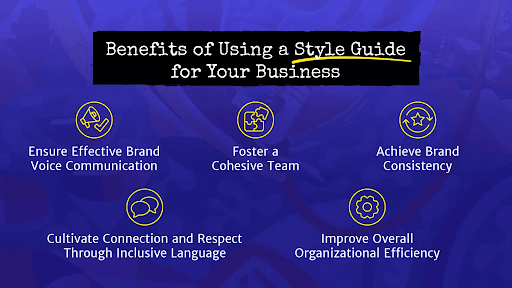
6. Connect The Dots With The Right Omnichannel Tools
Omnichannel customer engagement platforms help you manage messaging across every touchpoint without breaking the flow. For example, a tool like CleverTap lets you run campaigns across more than 12 channels, including push notifications, email, in-app messages, and SMS, all in one place.
When your tools sync, you get smarter data management, better timing, and stronger results.
Here’s how to choose the best tool for your brand:
- Review case studies from your industry.
- Request a demo with your real use case to see if it fits your needs.
- Test the ease of use. If your team cannot use it confidently, it is a no-go.
- Start with your top 3 channels and make sure the tool supports those first.
- Talk to their sales team to ask about onboarding, pricing, scalability, and support quality.
- Check if it integrates easily with your existing tools like CRM, CMS, and analytics platforms.
- Evaluate data syncing speed and accuracy to avoid delays and mismatched records.
Conclusion
Gather your team and take a real walk through your customer journey. Where does your omnichannel customer engagement fall apart? Maybe your customers disappear after a chat or ignore your promo emails?
Do not try to fix everything. Just pick the one thing that is clearly holding people back. One sharp, focused move can spark a smoother, more connected experience across every touchpoint.
To make this easier, use tools like CrankWheel. Features like Instant Demos and Screen Sharing let you engage customers in real time and offer instant support. Sign up now and let’s strengthen your omnichannel tactics.
About the author
Burkhard Berger is the founder of Novum™. He helps innovative B2B companies implement modern SEO strategies to scale their organic traffic to 1,000,000+ visitors per month. Curious about what your true traffic potential is?
